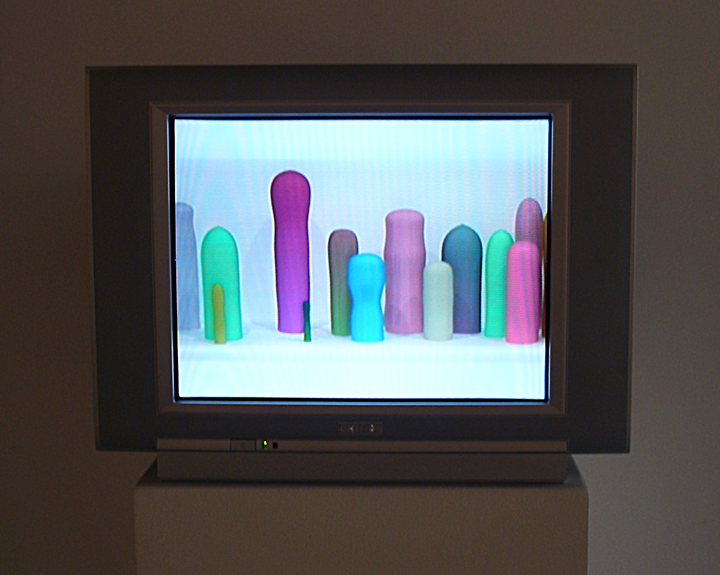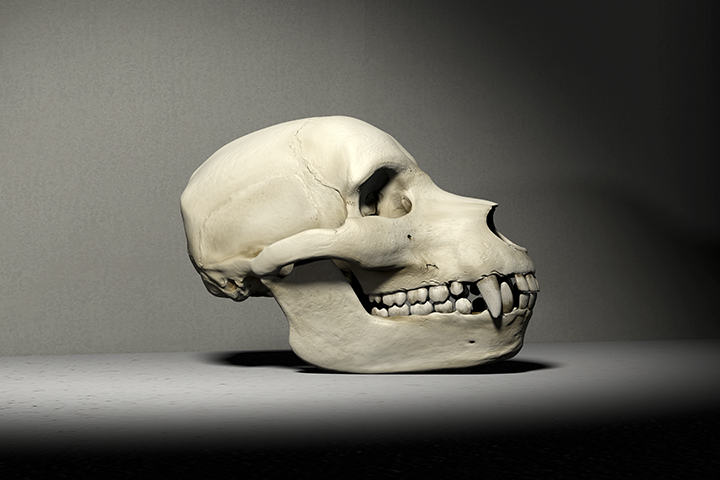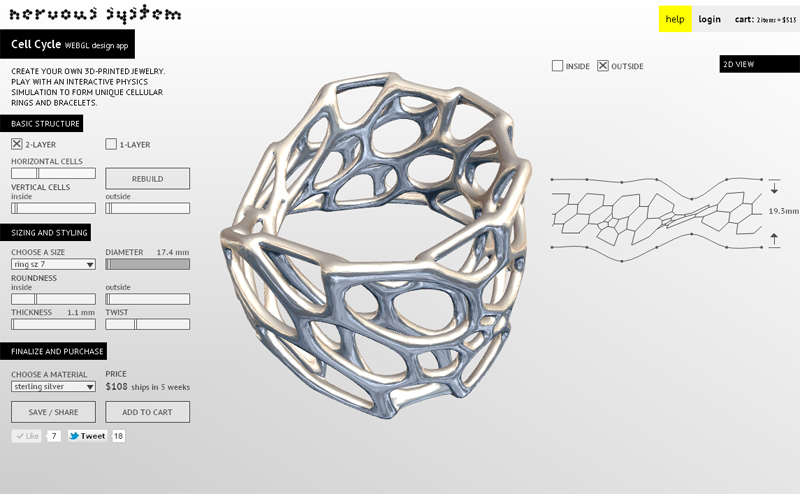
Generative sculptures by Marius Watz
Introduction
In this lecture, we’ll look at how algorithmic form and generative gestaltung (“form-making”) are employed in the arts, design, culture, entertainment, and hackery. This lecture is intended to prepare you for your Parametric Object assignment, #23, due February 10th. Although 2D parametric form is a venerable mode of inquiry, this lecture and assignment are focused on 3D form: not on images or representations, but on things.
Terms.
A parametric object is a “meta-form”: a mutable or variable object, produced by a set of rules, whose properties are governed or articulated by the values of certain variables or parameters. Change the values of the variables — and the form changes in response. Generative design is the activity of authoring the systems of rules that generate parametric objects. Sometimes designer-developers create a tool that generates forms, and then give that tool to a user; other times, the designer-developer is the sole intended user of her own tool.
Here’s an entertaining parametric, generatively-designed object which you may have seen recently: a set of 3D-Printed “Blooming” Fibonacci Zoetrope Sculptures by John Edmark, which was just published last week. A set of explicit geometric equations (mimicking phyllotaxis) are used to position the object’s features :
The simplest parametric systems just have a set of variables which each control various independent visual properties. Here’s a schema for a parametric vase, for example, with independent variables for a vase’s height, width, mouth flare, and neck width. A wide variety of forms are possible, within a well-circumscribed design space. It’s easy to imagine controlling such properties with a UI made of knobs or sliders.

Here‘s a design system for a parametric human body. But the sliders are no longer independent; instead, they affect each other in interrelated ways, with complex functional dependencies, as articulated through a sophisticated model of body shape variation. Increase the model’s weight, and his waist circumference, necessarily, must expand.

Artist-researchers interested in organic morphogenesis cannot achieve lifelike forms with explicit control: there is no equation to generate a cat. (Well, actually, here’s one). Instead, they use simulations in which millions of discrete elements (like particles) obey systems of simple rules with emergent properties (like flocking behavior). To achieve this, the “control parameters” must shift from first-order controls (width, height, etc.) to second-order controls that regulate the variables in a simulation (such as “cell division rate”, “inter-cell attraction force”, “nutrient density”) that then articulates the form. Andy Lomas explores such rule-generating systems in pure 3D abstractions that are highly organic.
Early History.
There is a long history of parametric design of 2D and computer-graphic forms. In this section our focus is on parametric 3D objects, and specifically on parametric 3D objects that can (or could) be realized through computer-aided fabrication and direct-digital manufacture.
“Computer-numeric controlled” (CNC) milling machines were first developed in the early 1950s, primarily for military and aviation uses; the first CNC patent was awarded to MIT in 1952. As with digital computers, the first CNC machines were extremely expensive, complex, and few. During the Cold War, the United States, fearing the possibility of its Air Force falling behind the Soviet Union’s in a “bomber gap“, greatly increased its military spending, and CNC machinery proliferated. Soon after this, and only shortly after the birth of 2D computer arts in 1965, the earliest non-utilitarian use of a computer controlled milling machine was by the computer-arts pioneer Charles (Chuck) Csuri, in his Numeric Milling sculptures (1966-1970).

>> Csuri’s wooden sculpture Numeric Milling is one of the few early computer sculptures created with a computer-driven milling machine… This work made use of the Bessel function to generate the surface. The computer program then generated a punched tape to represent the coordinate data. Included were instructions to a 3-axis, continuous path, numerically controlled milling machine.
In parallel with the development of CNC was the development of CAD, or techniques for describing forms through equations and algorithms. The Bezier Curve, for example, was ‘invented’ in 1959.
What shall we exclude from our discussion?
For the purposes of our Parametric Object assignment, I’d like to stick to parametric objects and forms we can generate with code and fabricate with machines. It must be said, however that there is a wide range of process-based generative art and rule-based generative art that does not use code. SCUMAK by sculptor Roxy Paine, a machine that creates blobby plastic forms, is an excellent example. Each of the forms “generated” by the machine represents a negotiation between “parameters” represented by device settings and natural random forces in the physical world. Perhaps I will add the requirement that our forms be repeatably generable.
Another interesting case is NODE10 3931 by the artist John Powers. This is a “rule based” piece of handmade generative art, assembled quasi-improvisationally by Powers from blocks of styrofoam.
Contrast this with the PolyMorph project by Cornell architecture professor, Jenny Sabin. Sabin has used generative computer techniques to design a family of interconnectable modular ceramic units, and other scripts to design their arrangement.
Essential part-to-whole relationships abstracted from mathematical and natural systems are explored through the design and 3D printing of 1:1 scale non-standard components on a 3D printer. A bespoke script based on networking behavior and recursive properties generates PolyMorph. The density of the network is constrained by material properties inherent to working with clay. […] Mathematical scripts are used as a sketch tool to explore experimental geometries that share synthetic relationships with networking models found in nature. Through subtle adjustments of mathematical and geometric parameters designed and organized in a set of simple components, it is possible to simulate and inhabit geometry as nature does, absent of representation and translation, in a constant formation, where geometry and matter are one–taking not one, but many forms and structures.
Inspirations I: Parametric Objects in the Artwork of Jason Salavon
Let’s jump ahead. Here’s a case study: a consideration of parametric objects in the past decade of work by a single artist, Jason Salavon, who has created some generative forms that are both beautiful and provocative. Here is Salavon’s suggestive Form Study #1 (2004), a near-infinite collection of generated objects designed to tickle the eye and, perhaps, the body. (Also see the online “toy version“):
[topswf swf=’https://ems.andrew.cmu.edu/2015/wp-content/uploads/2015/01/FormStudyFlash20.swf’ width=’640′ height=’400′ quality=’best’ wmode=’transparent’ scale=’default’ flashvars=” allowfullscreen=’false’] Jason Salavon, Form Study #1 (2004)
There is nothing wrong with making the world a more beautiful place, and there are centuries of craft, decorative arts and other forms of design to support this. Nevertheless, a critique sometimes leveraged at generative arts (by critics oriented toward conceptual and political cultural practices) is that generative art is purely ‘formalist’. In this project, Salavon shows that this need not be so; these cylindrical objects function equally well as colorful abstract form studies, and irreverent provocations. (For additional research in generative phallic juvenilia, also see Matthew Epler’s Grand Old Party visualizations and this generator by Henning Diesenberg.)
In 2007, Salavon created a photo-realistic “dynamic painting” of parametrically-modifiable glassware, in his Still Life II (Glassware). Note that the documentation video below is significantly accelerated; here it is shown at 50x speed. In ordinary observation, the changes would be almost imperceptible:
More recently Salavon has made a parametric mammal skull, in his Still Life (Vanitas), 2009:
Jason Salavon, Generic Mammal Skull (13% baboon, 36% bear, 46% human, 5% wild boar).
The above example is sped up 500 times (1 second becomes nearly an hour), revealing the subtle transformations that take place over the course of days. Jason Salavon’s work is produced at a high level of craft. Apart from their surface beauty, however, what makes these works interesting, memorable, or provocative? What strategies does Salavon use to do this? What visual languages does he engage?
What we can assert is that Salavon has created “meta-artworks”. Each individual object — a glass or a skull, etc. — is not so interesting in itself; but a machine which creates infinite varieties of them, is. The artist has designed rules that circumscribe a large yet coherent form space. At the same time, the resulting forms are placed within a visual context (for example: Renaissance painting, or Modernist industrial design) that frames and layers these forms with additional meanings.
Inspirations II: Data Sculptures and Physical Visualizations
Forms can also be generated from data. This can provide a better or different way of visualizing and apprehending three-dimensional information. It can also make data something tactile. The key aspect of generativity here is that the generated forms are the result of an algorithm metabolizing some specific data. Changing the data produces (or would have produced) different forms.
The form results from the data, instead of a random process (i.e. hit a button, get a new variation) or an interactive one (i.e. a user adjusts some sliders or performs some action which governs the outcome to their tastes).
The collection of physical visualizations in this section are all taken from the impeccably well-curated list at http://dataphys.org/list/; there’s plenty more inspiration there. All of the following things were made with code — or could have been.
Here’s a unique handmade 3D visualization that must have taken considerable effort, given that it represents more than 17,500 data points. It is Detroit Edison Company’s visualization of power consumption from 1935:

>> A large 3D physical visualization made by the Detroit Edison Company showing electricity consumption for the year 1935, with a slice per day and each day split into 30 min intervals. Used to better anticipate power demands.
Nowadays we use computers and digital fabrication machines. Maps are another easy-to-understand form generated from data. Here are Wolf-Dieter Rase’s Physical cartographic visualizations of Germany:

Much more abstract data can be represented, too. Consider this physicalized histogram: Mike Kneupfel’s Keyboard Frequency Sculpture (letter frequencies spatialized onto a QWERTY keyboard):

Timelines are another classic visualization technique which can be transposed to the physical domain. Here, in a design by David Bizer, the timeline of an audiofile is encoded in a form of revolution, and then 3D printed in silver using Selective Laser Sintering:
For another jewelry item, here is Mitchell Whitelaw’s Weather Jewelry (weather timelines encoded onto bracelets):

Some designers have used algorithmic techniques to generate 3D forms from graphs, such as from the locations in which a person has traveled. For example, Rachel Binx and Sha Hwang created Meshu, a fabrication-on-demand business which 3D-prints custom jewelry graphs based on places meaningful to the customer:


Another example is the project Loci by CIID student Andrew Spitz, which creates decorative objects (memorabilia) about one’s travels:

Here is a different set of computationally-generated timelines which are more controversial, both in their choice of data, their form, and their ostensible use: Matthew Epler’s political satire, Grand Old Party. These are Gallup polling timelines from the 2012 presidential election, encoded into butt-plugs:

As Epler shows, data-driven physical visualizations, married to specific kinds of objects — especially those we use in intimate body rituals — have a strong power to provoke. Here is (CMU alum) Nadeem Haidary’s In-Formed Tableware (global food consumption data encoded into fork tines as bar charts):

Some computationally-generated physical visualizations are not necessarily novel in their form, but allow new audiences to appreciate graphical representations of data — such as these tactile graphs for the blind by Amy Hurst:
Other creators have used physical visualizations to manifest ‘data’ that is directly provided by visitor-participant-users. For example, the group FrontDesign creates furniture through the algorithmic processing of human gestures recorded through motion-capture:
3D-printed portraiture (e.g. photobooths) are already a reality in Japan. Here’s an early example, Be Your Own Souvenir created by design group blablabLAB, which used a Makerbot, multiple Kinects, and custom software to create 3D printed body scans on Barcelona tourist streets (jump to 1:30):
Here’s a less typical physicalization of portrait data, the Fahz (“your face in a vase”):

Inspirations III: “Post-Industrial” Object Design
Algorithmic strategies for form generation are widely used in architecture, industrial design and the decorative arts.
Here’s a very straightforwardly algorithmic object: Fractal Table, developed by Platform Wertel Oberfell together with Matthias Bär. The branches keep subdividing until their terminals form the table surface:

Here’s another typical example, in which algorithmic techniques are driven by ‘data input’ from the world. This is customized “generative eyewear” by Swiss designer Adrian Gögl of OAK & DUST. He writes that “the customer can select these new spectacles during a consulting interview and they are fitted to his head as bespoke eyewear. The milled nose bridge made of cork is made to measure with a 3D-scan of the customers nose.” Gögl generates the eyeglass frames using a custom Grasshopper script.
CMU Architecture student Madeline Gannon has been investigating the combination of Kinect-based body-scanning, simulated physics and rapid prototyping to generate more exotic custom apparel, in her project Reverberating Across the Divide:
The duo Nervous System (Jessica Rosenkrantz and Jesse Louis-Rosenberg) have been doing highly influential work in the computational design of decorative and utilitarian objects. Here is one of their approaches to parametrically defined jewelry, a browser-based web service that allows user-customizable ring designs to be fabricated by direct digital manufacture. Their particular interest is in biomorphic generativity, i.e. generative design that mimics natural principles.
- Nervous System CellCycle Ring Creator
It is worth pointing out that Nervous System is (just) a two-person company, Jessica Rosencrantz and Jesse Louis-Rosenberg. Both are designer/coders with strong mathematics backgrounds.
[Show Nervous System jigsaw puzzle]. Their projects are strongly deserving of your contemplation, especially their user-controlled design tools.
Their custom-fit 3D-printed Kinematics dress is a tour-de-force of computational design and digital fabrication. Particularly worth a look are their design tool (which bases the dress on an uploaded 3D scan of the customer’s body) and the special techniques they developed to fit the dress, folded, into a practical build volume for 3D printing.
The “Wanderers” project by MIT Media Lab professor Neri Oxman, In collaboration with Christoph Bader & Dominik Kolb, is another memorable recent project using biomorphic strategies to generate organic, 3D, rapid-prototyped ‘wearables’ in controlled, parametric ways.
Oxman and her collaborators have conceived different sorts of ‘wearables’ with such tools.

Recently, Reza Ali published this lovely Instructable on generative 3D puzzles based on Voronoi diagrams.
Reza has many other nice projects involving generative form and digital fabrication. Generative (jigsaw) puzzles have also been created by Nervous System, again based on principles from nature — in this case, dendritic solidification, a crystal growth process:

Some 3D printers are “meta-material” printers that can print a variety of materials simultaneously in the same object, such as rubber and plastic. This has led to innovations, not just in how generated objects appear, but in how they can behave. Here is work by Disney Research in optimizing the inertial moments of 3D objects by cleverly varying their density:
In a different vein, pushing the resolution limits of what can be achieved with today’s 3D printers, Amanda Ghassaei has developed Processing code (and this Instructable) to generate CAD models for 3D-printed “vinyl” records from any audio file:
Here’s an project of my own, a parametric system for generating rubber stamps from any logo, extensible to wheels and (even) shoes, as a kind of graffiti tool:
Finally, it’s worth considering Disarming Corruptor by Matthew Plummer-Hernandez, which (reversibly) corrupts 3D models in order to allow for the undetected transmission of contraband CAD files (such as the Liberator).
Inspirations IV: Parametric Everyday Objects with OpenSCAD
Humble objects deserve our consideration, too.
Generative art and design are large fields with many different approaches, and many tools that support different objectives and workflows. Widely-used algorithmic modeling environments include Processing, PLaSM, Rhino+Python, and Grasshopper. In this section, we consider how people are using OpenSCAD, a C-style geometry scripting language and CSG compiler, to create parameterized everyday objects. OpenSCAD is free software and available for GNU/Linux, MS Windows and Mac OSX. It provides two main modeling techniques: First, constructive solid geometry (CSG) and second, extrusion of 2D outlines.
OpenSCAD is well-suited for creating parametric objects, such as a chain that can have any number of links, or a snowflake ornament with a changeable pattern. Here, perhaps, is the simplest and most introductory example, a customizable box: http://www.thingiverse.com/thing:72070.
OpenSCAD has been used to create a variety of useful parametric objects:
- Wall plate customizer: http://www.thingiverse.com/thing:47956
- Customizable cable tie: http://www.thingiverse.com/thing:58776
- Universal tool mount: http://www.thingiverse.com/thing:218762
- Tractrix horn generator: http://www.thingiverse.com/thing:218241
- Generic wheel: http://www.thingiverse.com/thing:21486
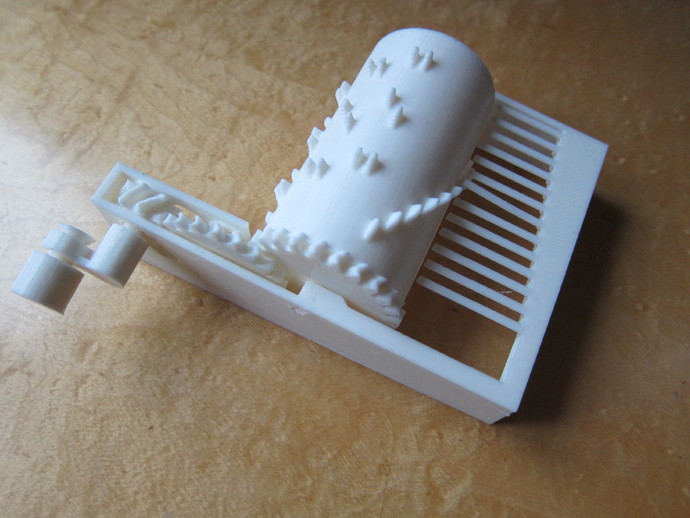
It has also been used to create a variety of more fanciful and whimsical ones.
- Fraction Blocks (by Bitcraft Lab): http://www.thingiverse.com/thing:218491
(Check out the inspiration for this one, and see why OpenSCAD was a natural solution.) - Parametric music box: http://www.thingiverse.com/thing:53235
- Decorative word pen: http://www.thingiverse.com/thing:148722
- Customizable word rings: http://www.thingiverse.com/thing:48424
- Vase/cup generator: http://www.thingiverse.com/thing:86476
- A 2014 IACD student, Spencer Barton, made this OpenSCAD Braille Fridge Magnet: https://ems.andrew.cmu.edu/2014/spencer/01/23/openscad-braille-fridge-magnet/
If you enjoy information visualization, it is also possible to use OpenSCAD to generate sculptures that represent data. Below is a 3D-printable “prism map” of the USA; by loading a data file representing data for each state (e.g. population, number of Starbucks, etc.) a different sculpture is generated:
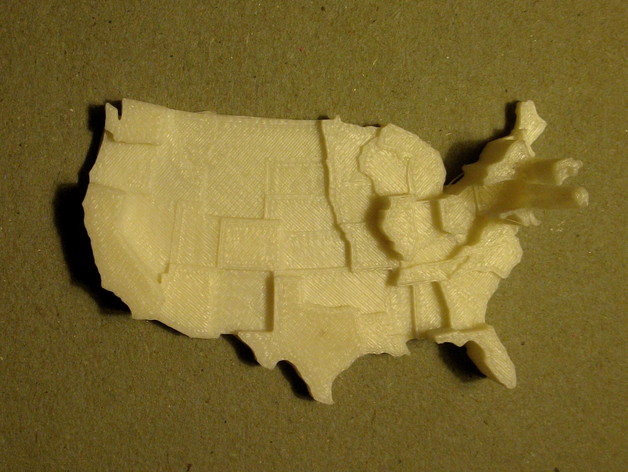
- USA Prism Map: http://www.thingiverse.com/thing:209005
OpenSCAD models can be imported into MakerBot’s user-oriented Customizer software, which exposes OpenSCAD variables as sliders in a browser-based GUI for easy shape generation. (In other words, it serves as a front-end GUI for your code.) Here are some galleries featuring more examples of parametric OpenSCAD objects, many of which are associated with Customizer:
- http://www.thingiverse.com/tag:customizer
- http://www.makerbot.com/blog/2013/03/10/makerbot-customizer-challenge-winners/
- http://www.openscad.org/gallery.html.
More Inspiration
The links below are taken from the parametric design curriculum that my friend Marius Watz taught at ITP in 2013.
- Flickr: Digital fabrication
- pinterest/watz: Digital fabrication
- pinterest/Andrew Kudless
- pinterest/Trang Nguyen
Parametric World Tumblr
Marius cautions: “As it turns out, Pinterest and Tumblr are excellent sources for inspiration and research, at least in the sense of providing an endless stream of images. Unfortunately, the widespread lack of proper accreditation can make it difficult to trace the origin of works and learn more about the context of their creation.”
Finally, if time allows, I recommend this TED talk by Michael Hansmeyer on Generative Form-Making (11′). His most important insight is in the idea of surface properties (such as local curvature) acting in feedback with generative processes.



